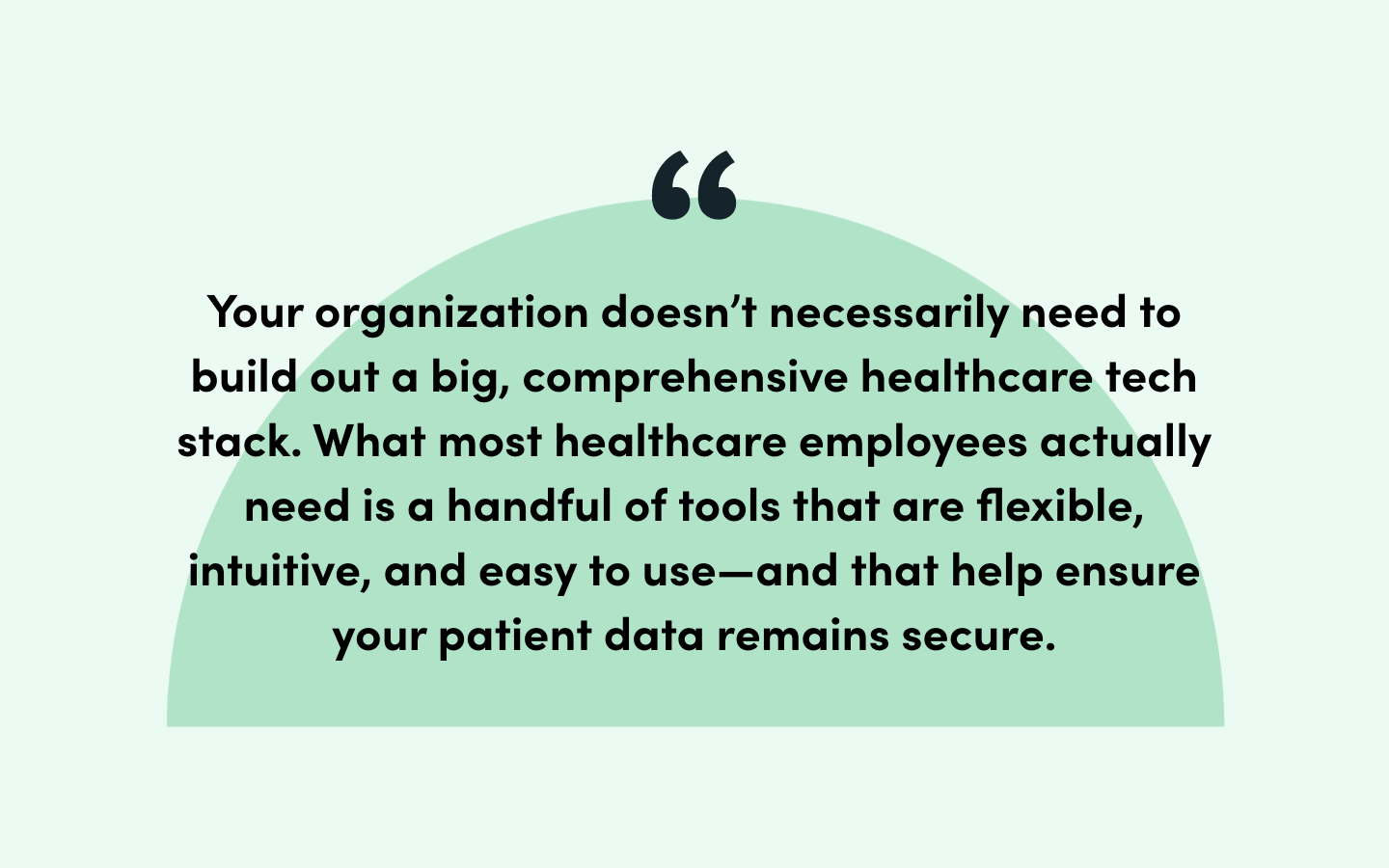The healthcare industry is undergoing a major transformation.
From curbside check-ins and parking lot waiting rooms to telemedicine and virtual care, today’s patients have all kinds of expectations for healthcare technology.
The good news is that, with the right tools, it’s easier than ever to meet those expectations—and make day-to-day workflows easier, too. You just have to know what to look for.
When it comes to finding the right healthcare technology, digital agility is key. Your organization doesn’t necessarily need to build out a big, comprehensive healthcare tech stack. What most healthcare employees actually need is a handful of tools that are flexible, intuitive, and easy to use—and that help ensure your patient data remains secure.

The question is: How do you identify the right tools for your patients and staff?
If a healthcare software vendor meets the short list of the most important criteria listed below, there’s a good chance you’ve found a strong technology option.
1. Does it meet HIPAA security and compliance standards?
To understand why you should pay close attention to healthcare software security, consider what happened at AdventHealth.
For months, the hospital system had been using a website form builder employees believed to be secure. That is, until a zero-day vulnerability was exploited and patient data was put at risk. When that happened, the team had to scramble to find a different solution—after staff had already embedded hundreds of online forms to collect patient data on the hospital system's websites.

In this case, the team was able to quickly transition to a different form builder designed with HIPAA data security in mind. But the experience serves as a learning tool for other companies across industries.
Before adopting new technology, it’s critical to first determine which security and compliance features are "must-haves" for your organization, and make sure any new tools meet your criteria before adding them to your tech stack.
Related: 5 Questions to Ask Before You Buy a HIPAA Compliant Software
2. Is the technology easy to use by anyone?
More than ever, it’s highly important to have no-code technology your entire office can use to meet day-to-day needs. When staff members have to contact IT any time they need to do something new or different, the result is long lag times—and that’s something no one wants to contend with. It means the product is too technical for the average healthcare employee to easily understand and use.
Listen to the full Ripple Effect podcast episode: Simplifying Processes in the Digital Age
While reliance on IT may have been a necessity a decade or so ago, this is no longer the case. Much of today’s healthcare technology is designed to be easy to set up and easy to use, all without having to understand a single line of code.
For example, if you’re using a workflow management platform, anyone at your organization should be able to set up processes to automate patient onboarding, streamline patient registration, build a referral process, and reduce wait times. And they should be able to do it all quickly and easily, with pre-built integrations and intuitive tools that only require them to drag, drop, swipe, and click.
When selecting new technology, look for reviews from other healthcare professionals who rely on the tool and can vouch for its ease of use.

3. Is the new tool cost-effective?
If your organization is still using legacy technology, such as a highly specialized system that’s been in place for years without much change, it may be time to consider a replacement.
The healthcare technology industry has advanced a lot in recent years, and it’s freeing practices and providers to move away from traditional software toward SaaS subscriptions. These cloud-based solutions tend to come with numerous benefits that aren’t available with legacy systems—ongoing security updates, frequent product enhancements, prebuilt integrations, and more—all without the high price tags of traditional healthcare software solutions.
When evaluating vendors, be sure to look for clear and simple pricing that will stay consistent as your needs change.

Pro Tip: Unsure how to best review software you’re considering adding to your healthcare tech stack? Use our checklist on the 7 things to consider before buying software to guide your decision.
Start Building a Secure Healthcare Tech Stack
Creating a contactless, digital-first world in the wake of COVID-19 has become a high priority for all industries—and healthcare is no exception.
As you consider your options for modernizing your healthcare tech stack, remember to prioritize quality over quantity. You might only need one or two new solutions. Just make sure you’re confident they’ll provide the features you need to continually meet patient needs as they evolve.
Need help deciding which software to add to your healthcare tech stack? Download our Digital Transformation Checklist as a guide to help plan, prepare, and adopt the best tools for your practice.











